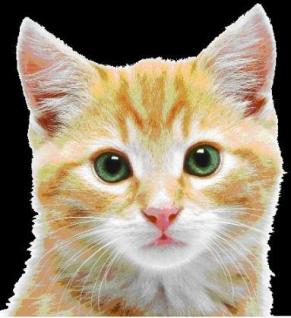Adaptations
The domestic cat has acquired many adaptations throughout
history. In the family Felidae, cats have evolved to live
solitarily (without presence of a group) with the exception of
the lion and cheetah. This family has also evolved into
agile and efficient hunters. (If you would like to see a cat's
stalking skills YouTube 'stealth cat.') They are "crepuscular", hunting
during dawn and dusk, when their prey is more active. This
makes cats sleep during the daytime and at night, about 16 hours
of the 24 hours. In fact cats sleep about 2/3 of their
lifetimes!
 Cats'
eyes have very well adapted photoreceptors for seeing in the
dark and to help spot and catch their prey. Their ears have also
been adapted for hearing better.. The tail on cats is usually
long and flexible, aiding in balance. Domestic cats have a
compact, flexible body-making it easier to move. Also, cats have
retractable claws, with the cheetah as an exception- for
domestic cats, this helps them be a better pet. In
order to help them move swiftly, cats walk on the tips of their
toes, as opposed to on the balls of their feet like
dogs. Also, compared to other mammals the cat's small
intestine is much smaller. This allows for a quicker metabolism
and more energy intake.
Cats'
eyes have very well adapted photoreceptors for seeing in the
dark and to help spot and catch their prey. Their ears have also
been adapted for hearing better.. The tail on cats is usually
long and flexible, aiding in balance. Domestic cats have a
compact, flexible body-making it easier to move. Also, cats have
retractable claws, with the cheetah as an exception- for
domestic cats, this helps them be a better pet. In
order to help them move swiftly, cats walk on the tips of their
toes, as opposed to on the balls of their feet like
dogs. Also, compared to other mammals the cat's small
intestine is much smaller. This allows for a quicker metabolism
and more energy intake.
 The
ability to purr is also an adaptation for cats, this is greatly
showcased in domestic cats. In large cats, the bones by the
throat are partially cartilage, therefore the throat is more
flexible and able to support a roar. In small cats, the throat
bones are rigid so roaring is not possible.
The
ability to purr is also an adaptation for cats, this is greatly
showcased in domestic cats. In large cats, the bones by the
throat are partially cartilage, therefore the throat is more
flexible and able to support a roar. In small cats, the throat
bones are rigid so roaring is not possible.
To learn about the habitat and geography of
the domestic cat, click
here.